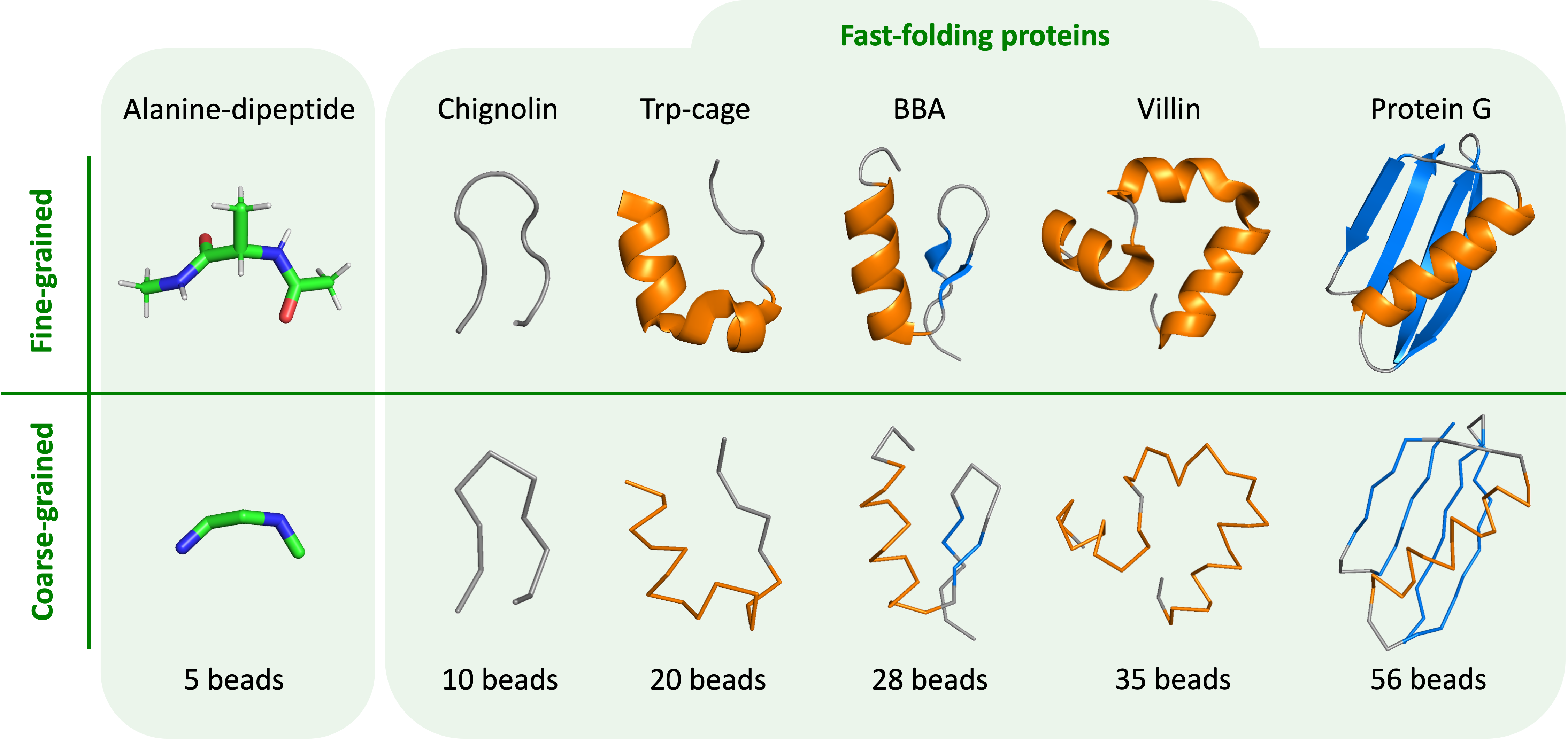This Denoising Force Field (DFF) codebase provides a Pytorch framework for the method presented in Two for one: Diffusion models and force fields for coarse-grained molecular dynamics. This paper features a denoising diffusion model that is trained on coarse-grained protein dynamics data and can be used in two different settings:
- Standard density modelling
$\rightarrow$ i.i.d. sampling from the equilibrium distribution. - Extract the learned score
$\rightarrow$ get the coarse-grained force field$\rightarrow$ use for Langevin dynamics simulations.
Dependencies are listed in coarse-graining-environment.yml and can easily installed as an environment (named coarse-graining-environment) through miniconda or anaconda by running
conda env create -f coarse-graining-environment.yml
Trained models per protein can be found in the saved_models folder.
We include all test cases from the paper:
- Alanine dipeptide (4 folds)
- Chignolin
- Trp-cage
- BBA
- Villin
- Protein G
For each protein, we provide a model-best.pt file with the checkpoint corresponding to the best validation loss as well as an args.pickle file containing the arguments used for that run.
Sampling for each protein can be done in either the i.i.d. setting or the dynamics setting using the sample script. As an example, we show simple commands for obtaining chignolin samples in both settings. We refer to python sample.py --help for more sampling options and an explanation of all individual arguments.
Generating 1000 i.i.d. samples using a pretrained model:
python sample.py
--model_path saved_models/chignolin
--gen_mode iid
--num_samples_eval 1000
--batch_size_gen 256Running 100 simulations of 10000 time steps, saving with an interval of 200 time steps. This will result in 5000 saved samples (= 100 x (10000 / 200)). Using the argument noise_level (here set to 20), the user can specify the diffusion model noise level used to extract force fields for Langevin dynamics.
python sample.py
--model_path saved_models/chignolin
--gen_mode langevin
--noise_level 20
--parallel_sim 100
--n_timesteps 10000
--save_interval 200The commands used to sample the Langevin dynamics as in the paper are provided in ./evaluate/sampling_commands.md
In evaluate, we provide notebooks to exemplify how to evaluate generated samples with respect to the reference dataset. Since we assume that the reference data is not available, we provide reference distributions and TIC models in saved_references. We split the test cases into alanine dipeptide and the fast-folding proteins.
The evaluate_ala2 notebook can be used to evaluate alanine dipeptide in terms of dihedral free energy.
The evaluate_fastfolders notebook contains all evaluation for the fast-folding proteins:
- Pairwise distances
- Time-lagged independent component analysis (TICA)
- RMSD to native (folded) structure
- Contacts
- State transition probabilities (for dynamics only)
A more detailed description of each analysis is provided in the notebook.
Important
This codebase does not provide data. We refer to this webpage (file: ala2_cg_2fs_Hmass_2_HBonds.npz) from FU Berlin for freely available alanine dipeptide simulation data.
Fast folder data can be requested from D. E. Shaw Research as described in the original paper.
This code base is mainly aimed at sampling and evaluation using pretrained models. However, the DFF model was trained from scratch using the training script. The underlying code for the DDPM and graph transformer can be found in the models folder. For training options, please check:
python main_train.py --help- DDPM base model (PyTorch) by Phil Wang (lucidrains)
- Graph transformer (PyTorch) by Phil Wang (lucidrains)
- Several plotting functions provided by the authors of Flow-matching: Efficient coarse-graining of molecular dynamics without forces.
- Langevin dynamics from CGnet (PyTorch), by the authors of Cgnet: A light-weight context guided network for semantic segmentation.
Please cite the following paper when using this code base:
MLA:
Arts, Marloes and Garcia Satorras, Victor, et al. "Two for one: Diffusion models and force fields for coarse-grained molecular dynamics." Journal of Chemical Theory and Computation 19.18 (2023): 6151-6159.
BibTeX:
@article{arts2023two,
title={Two for one: Diffusion models and force fields for coarse-grained molecular dynamics},
author={Arts, Marloes and Garcia Satorras, Victor and Huang, Chin-Wei and Zügner, Daniel and Federici, Marco and Clementi, Cecilia and No{\'e}, Frank and Pinsler, Robert and van den Berg, Rianne},
journal={Journal of Chemical Theory and Computation},<br>
volume={19},
number={18},
pages={6151--6159},
year={2023},
publisher={ACS Publications}
}This project welcomes contributions and suggestions. Most contributions require you to agree to a Contributor License Agreement (CLA) declaring that you have the right to, and actually do, grant us the rights to use your contribution. For details, visit https://cla.opensource.microsoft.com.
When you submit a pull request, a CLA bot will automatically determine whether you need to provide a CLA and decorate the PR appropriately (e.g., status check, comment). Simply follow the instructions provided by the bot. You will only need to do this once across all repos using our CLA.
This project has adopted the Microsoft Open Source Code of Conduct. For more information see the Code of Conduct FAQ or contact opencode@microsoft.com with any additional questions or comments.
This project may contain trademarks or logos for projects, products, or services. Authorized use of Microsoft trademarks or logos is subject to and must follow Microsoft's Trademark & Brand Guidelines. Use of Microsoft trademarks or logos in modified versions of this project must not cause confusion or imply Microsoft sponsorship. Any use of third-party trademarks or logos are subject to those third-party's policies.

